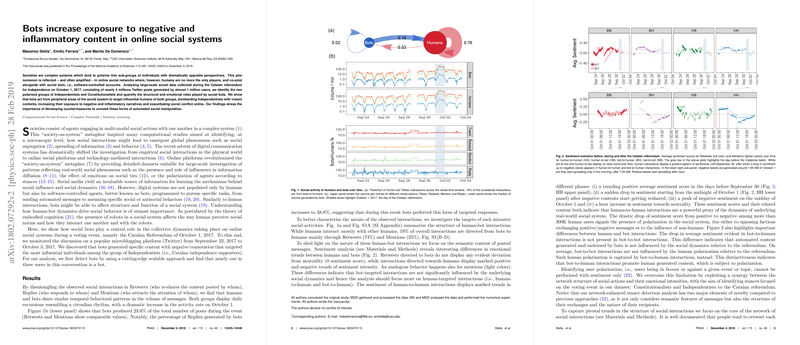Overview of Bot-Driven Exposure to Negative Content in Social Media
The paper by Stella, Ferrara, and De Domenico investigates the influence of bots on the polarization and dissemination of negative content on online social platforms during high-stakes political events, using the Catalan referendum of October 2017 as a case paper. By analyzing approximately 4 million Twitter posts from nearly 1 million users, the authors highlight the dichotomy between Independentists and Constitutionalists and assess the strategic role bots play in this socio-technical landscape.
Key Findings and Methodology
The authors employ a combination of advanced techniques in computational social science, including bot detection, sentiment analysis, and network analysis, to unravel the contributions of bots in shaping social interactions. Notably, they deploy a scalable feature-based method for bot detection, revealing that around 30% of users were bots. Bots, operating from the network's periphery, specifically targeted human influencers, potentially amplifying negative content.
The research delineates online interactions into Retweets, Replies, and Mentions, observing that bot interactions contributed 23.6% of the total posts, with Replies showing an increased involvement to 38.8%. The sentiment analysis further differentiates the emotional content bots and humans engage in, marking a significant drop in sentiment on the referendum day among human-to-human and bot-to-human interactions.
Network analysis identifies two distinct polarized factions within this social milieu, primarily differentiated through retweet patterns and sentiment scores, aided by an efficient Fiedler vector approach. Both groups had a substantial presence of bots, yet with differing levels of human-bot interactions, indicating a varied influence on social dynamics.
Implications and Theoretical Perspectives
The nuanced semantic analysis of hashtag usage adds depth, displaying marked differences in conceptual associations between groups. This demonstrates the bots' role in accentuating group identity through hashtag strategies related to controversial topics like independence, antagonism, and state actions.
The paper underscores a dual narrative of bots as facilitators of social contagion through both amplification of human-generated content and creation of strategically polarized, automated content. This reveals the potential magnitude of bot influence in fostering social strife by enhancing exposure to inflammatory content, a concern that extends to broader online disinformation campaigns. The strategic targeting and semantic construction of bots provide clear evidence of their ability to escalate online discourses into tangible societal tensions.
Future Directions in AI and Social Systems
The findings beckon further exploration into the boundaries of bot engagement and its regulation within digital platforms, particularly during critical political events. There is a pressing need for developing improved computational models to detect and mitigate such forms of automated social manipulation, ensuring the reliability and integrity of socio-technical systems. Researchers are prompted to investigate how these patterns apply across different social media and cultural contexts and to refine detection mechanisms incorporating real-time analytics. As AI continues to evolve, the challenge lies in balancing its disruptive potential with ethical applications that safeguard public discourse and maintain sociopolitical stability.
